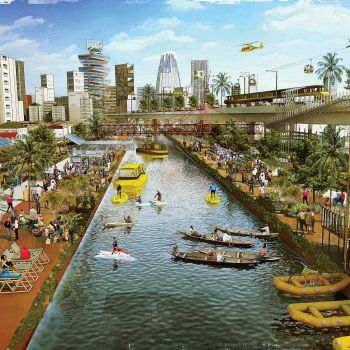
Last summer a man in Burgettstown, Pennsylvania, painted a 25-mph speed┬álimit on the Main Street asphalt to keep drivers from speeding through town. An artist in Chicago has been filling potholes with floral mosaics. Mumbai has just started banning cars from four miles of major roads on Sundays. Paris dumped sand all over a riverside highway, turning it into a temporary beach. Each of these interventions is an example of tactical urbanism, the buzzword du jour for improvised, low-cost, and not necessarily legal tweaks meant to trigger swelling ripples of reform. The concept is as old as the hawkers of antiquity who spread out a blanket in a plaza, turning a ceremonial space into an open market. I suspect Socrates would have recognized the concept of a pop-up caf├®. Lately, though, itÔÇÖs acquired a new intellectual heft. The think tank Project for Public Spaces uses the motto ÔÇ£Lighter, Quicker, CheaperÔÇØ as an antidote to the kind of juggernaut-style planning that reckons budgets in the billions and pours concrete by the acre. In keeping with the movementÔÇÖs brisk, neighborly spirit, the Street Plans ┬¡Collaborative has produced a series of handbooks on how to reorganize streets for maximum safety and pleasure. It all sounds simple and brilliant and right: Who could object to a bench, or to planting a garden in a de-paved parking lot?
Yet although the main focus of DIY urbanism in the developed world has been the Portlandian pursuit of pleasantness, less prosperous cities like Rio have far more urgent needs. With ÔÇ£Uneven Growth: Tactical Urbanisms for Expanding Mega┬¡cities,ÔÇØ the Museum of Modern Art is trying to wrest the term from the plane of neighborhood tinkering and project it on a massive scale. (The show opens November 22; this essay is based on the catalogue, which lays out its arguments, and a blog documenting MoMAÔÇÖs yearlong process.) The museum gathered six international teams of designers, held workshops, and guided a set of proposals to stanch the worldwide tide of urban misery. The ┬¡disappointing result, full of pragmatic micro┬¡remedies, utopian ambitions, and razzle-dazzle renderings, attempts to face down the dystopian megalopolis, where rapacious oligarchs live in fortified palazzos encircled by boundless slums, where swelling hordes wade in sewage and forage on mountains of refuse. ThatÔÇÖs not even the future; megacities are growing at such dizzying rates that authorities can barely locate new neighborhoods on a map, let alone hook them up to water mains.
In the past, the museum used similar strategies to tackle climate change and the housing crisis, producing prescient, inventive shows organized by the former head curator of architecture and design Barry Bergdoll. This one, organized by Pedro Gadanho, feels shakier and more simplistic, predicated on a vague and reductive view of global economics and an inflated belief in the power of architecture. Design, the activist architect Teddy Cruz suggests in a catalogue essay, can either be ÔÇ£a decorative tool to camouflage the neoconservative politicsÔÇØ that have eroded urban life, or it can foment radical change. In other words, itÔÇÖs architectureÔÇÖs job to fix capitalism (or replace it), alleviate poverty, eliminate ┬¡corruption, and embolden the powerless. Better get cracking.
The showÔÇÖs ideology rests on the premise that obscene inequality results from the unbridled accumulation of capital, and that the neoliberal (confusingly, also called neoconservative) policy of privatizing everything in sight has turned cities into the playthings of plutocrats. All over the world, the rich have stolen public space, crushed the powerless, luxury-ized neighborhoods, bought police forces, and turned urban living into an exclusive perk for the few and an inescapable nightmare for the rest. Tactical urbanism, then, is the peopleÔÇÖs form of resistance. ÔÇ£Many of the protests of the past few years ÔÇö Tahrir Square, Los Indignados, Occupy Wall Street, Gezi Park, Tel Aviv, and others ÔÇö made legible the fact that occupying makes novel territory,ÔÇØ the sociologist Saskia ┬¡Sassen writes in the catalogue. Protests have the power to reshape public space and therefore to incite more democracy.
Somehow, though, MoMAÔÇÖs proposals rely not on tent cities but on big money, implausibly efficient governments, and the slow work of changing cultures. One team wants to expand Hong Kong with a mini-archipelago of floating islands. Another envisions Lagos as a Nigerian Venice, spreading glamorously into the water that now constitutes a foul threat. Two more focus on social rather than architectural structures. The Istanbul group insists that if residents of public housing could be trained to share meals, Wi-Fi, and workspaces, affordable-housing crises would be vanquished. The New York section ┬¡proposes a cooperative housing trust, essentially a new nonprofit bureaucracy that would succeed where others have failed. These approaches bear only the most distant kinship to the DIY park-bench-and-planter kind of cheap fixes. Taken together, they tinge ┬¡MoMAÔÇÖs project with condescension rather than optimism. Go ahead, enjoy your crumbling concrete patio, the Rio de Janeiro team suggests, laying out a catalogue of fictional home-improvement products, like a silver shade screen, reflective tiles, and plastic chairs. ItÔÇÖs healing via Home Depot.
One problem with MoMAÔÇÖs agenda-guided analysis is that urban conflict is not always a fight between the powerful and the oppressed. Just as often, it pits one activist group against another, each trying to remake the city according to its own desires. One citizenÔÇÖs helpful hand-painted crosswalk is anotherÔÇÖs vandalism; one personÔÇÖs liberating bike lane is anotherÔÇÖs encroachment; a flash mob of food trucks can be a delight or a plague, depending on your taste for soup dumplings or exhaust. Public squares are usually agnostic ÔÇö equally well suited to public hangings and peaceful encampments, ginned-up pro-government rallies and outpourings of popular outrage. To bastardize an awful slogan: Streets donÔÇÖt liberate people; people do.
If there is one figure who distills everything that MoMAÔÇÖs ideologues loathe, itÔÇÖs Michael Bloomberg, the quintessential billionaire bureaucrat. BloombergÔÇÖs administration saw rising land values as the ultimate measure of New YorkÔÇÖs success, but it also delivered bike lanes, pedestrian plazas, temporarily car-free boulevards, pop-up caf├®s, small-business incubators, microapartments, prefab construction, community-┬¡based zoning, and so on ÔÇö a record that might have been extracted from the Street Plans CollaborativeÔÇÖs tactical urbanism manual. Mayor de Blasio has pursued his ostensibly more inclusive, progressive agenda with similar tools: a 25-mph speed limit, new street designs ÔÇö and policies intended to encourage developers to keep doing what they do. These on-the-ground ironies get lost in the political muddle of MoMAÔÇÖs analysis. Professor Nader Tehrani sounds the usual warnings against neoliberalismÔÇÖs ÔÇ£pattern of privatization,ÔÇØ but also praises BloombergÔÇÖs signature project, the High Line, as an example of ÔÇ£informal processÔÇØ and a ÔÇ£testament to resilience.ÔÇØ Never mind that to create the High Line, activists collaborated with a sympathetic mayor, a gaggle of city agencies, the federal government, and the publicly traded freight company CSX ÔÇö or that the main driver of its success has been the creation of billions in real estate. ThereÔÇÖs nothing ÔÇ£informalÔÇØ about ChelseaÔÇÖs new super-luxury architectural zone, and in any case all the bashing of the wealthy and powerful feels disingenuous coming from an institution that has raised fortunes to take over virtually an entire city block.
These contradictions donÔÇÖt devalue the movement ÔÇö they just make it more complex than the museum is willing to deal with. Tactical urbanism has improved my life and probably yours. Its spirit is refreshingly retrograde, itÔÇÖs revived old ways of enjoying city life, and it relies on intimate knowledge of each neighborhood and block. What rubs me the wrong way is ┬¡MoMAÔÇÖs sanctimonious conflation of political belief, counterculture rhetoric, facile solutions, and economic na├»vet├®. If this is the best a research institution can come up with after more than a year of study, then the future of cities is dark.
*This article appears in the November 17, 2014 issue of New York Magazine.



